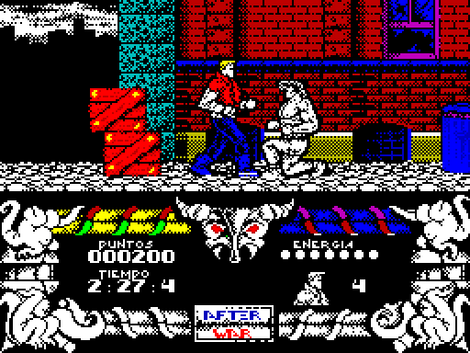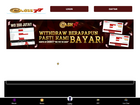Pojawiała się nowa odsłona emulatora ZX Poly autorstwa Igora Maznitsa. Głównym celem powstania emulatora nie było jak to zwykle bywa w takich projektach dokładne odtworzenie pracy maszynek Sinclair/Amstrad a rozwiązanie jednego z najbardziej irytujących ograniczeń Spektrusia, tzw. color clash, który ograniczał ilość kolorów do dwóch jakie mogły się pojawić w kwadracie 8x8 piksli. Wizualnie, color clash potrafił niejednemu obrzydzić gumiaczka, kwadraciki mocno irytowały (chociaż bardziej mnie irytowało zbytnia cukierkowatość grafiki na innych platformach;)). A gdyby pozbyć się tego efektu? Możecie sięgnąć po ZX Poly, który wykorzystuje aż 4 emulowane Z80 do przetwarzania grafiki (autor zafascynował się rozwiązaniami Pixar System, w którym za wyświetlanie jednego kanału odpowiadał osobny procesor), w efekcie oprócz pozbycia się irytującego efektu otrzymujemy również możliwość podkolorowania gier (prosty edytor jest dołączony do projektu).
Oczywiście w epoce UlaPlus, który jest praktycznie dostępny w każdym nowym emulatorze ZX Spectrum, efekt końcowy działania ZX Poly jest trochę pomniejszony (zważywszy, że i jego prędkość przez środowisko - Java i sposób emulacji powodują iż zabawa jest trochę śiermiężna), należy jednak pamiętać, iż pracę nad tym rozwiązaniem sięgają roku 1994.
Przy okazji warto też przypomnieć inny projekt, który pozwalał w zasadzie całkowicie zmodyfikować grafikę w grze - czyli Spec256, w którym cały proces wyświetlania grafiki był przechwytywany i pozwalał na podmianę jej w dowolny 256 kolorowy sposób (problem jednak tkwił w ilości pracy jaki trzeba było poświęcić na każdy tytuł - aby cieszyć się podrasowaną grafiką wymagał on przygotowania nowych elementów graficznych, stąd bardzo skromna biblioteka gier, które wykorzystują tą możliwość).

Sky Shark (a.k.a. Flying Shark) (Firebird Software, 1987) z modyfikowaną grafiką w ZX Poly

After the War (Dinamic Software, 1989) zmodyfikowana grafika w ZX Poly
ZX Poly 20/11/2019
- Supported snapshot formats: SNA, Z80
- Supported disk images: TRD, SNA
- Supported tap formats: TAP
→ NOWSZY [ZX] ZX Poly 2.3.3 21/10/2023
2.3.3 (21-oct-2023)
- improved z80 snapshot load to process 0-2 banks among 128 ram banks
- updated embedded JDK to 21.0.1+12
2.3.2 (23-mar-2023)
- added AppImage
- added way to decrease CPU use in non-turbo mode with option "Try use less resources" #35
- updated embedded JDK to 20+37
- minor improvements of Z80 emulation
- added Ula Plus palette support for animation GIF recording
- fixed restore indicator panel view flag after restart #86
2.3.1 (27-aug-2022)
- added support for ULA Plus palette #72
- added support for SZX snapshot
- fix for Virtual keyboard button #83
- added CLI support to define emulator start parameters through command line
- added Virtual keyboard skin Spectrum+2 Style #75
- fixed keyboard layout #66
- fixed turbo menu item sync with fast button #70
- updated embedded JDK to 17.0.4.1+1
→ NOWSZY [ZX] ZX Poly 2.3.0 02/05/2022
2.3.0 02-may-2022
2.2.3 (15-jan-2022)
- added virtual keyboard skin #57
- added emulation of MAGIC button #56
- improved bootstrap ROM selection in Preferences
- added support of ROM image loading as snapshots
- Fix for ZXPlus keyboard skin
- Added Timex2048Pal keyboard skin
- Added configurable fast buttons
- added new ROM sources
- Z80, refactoring of RETI instruction
- improved emulation of ZX128
→ NOWSZY [ZX] ZX Poly 2.2.2 19/12/2021
2.2.2 (19-dec-2021)
- added option 'Volume profile' to select audio volume profile
- added support for TZX tape snapshots #10
- added keyboard skins provided by @Alessandro1970
- provided way to change L&F and application UI scale
- improved Spec256 state snapshot save (works only for loaded Spec256 snapshots) #36
- decreased CPU usage
- embedded JDK updated to Liberica OpenJDK 17+35
- minimal required JDK level is 11+
2.2.1 (07-aug-2021)
- Old Color TV filter is ON by default (can be turned off in preferences)
- added support for interlace TV output (by default ON)
- improvement of border render
- added stereo sound for AY-channels (ABC by default, it is possible turn on ACB)
- embedded JDK updated to Liberica OpenJDK 16.0.2+7
- minor refactoring and improvements
Release 2.2.0 2.2.0 (24-jun-2021)
- improved emulation of index mark for FDD
- video output processing moved into end screen paint
- improved emulation of Command Type I for FDD controller #21
- fixed emulation of Z80 #30
- updated Launch4J launcher for Windows
- embedded JDK updated to Liberica OpenJDK 16.0.1+9
- the sprite corrector now embedded into emulator
- refactoring
2.1.3 (06-mar-2021)
- improved INT tick processing
- added support of WebSocket for streaming
- added auto-restore of sound after turbo mode off
- fixed reading of samples from unsigned 8 bit WAV
- reworked form resize processing #18
- added Old TV Amber and Old TV Green filters #15
- added toggle button to activate virtual ZX-Keyboard #17
- added auto-releasing for SS+CS on virtual keyboard #12
- added configurable Protek joystick and
ZX-Keyboard Off mode (either pressed F6 or flag in Options menu), to process
events only from selected joystick (ZX-Keyboard keys in the mode works only with pressed
CTRL) #11
- added way define custom ROM path through preferences #9
- added distributive for MacOS arm64 (game controller interface may not work)
- embedded JDK updated to Liberica OpenJDK 15.0.2+10
- added way change virtual keyboard skin through preferences #8
- added support for snapshot and file containers drag and drop into main form #7
- in Preferences added redefinition of keys mapped to Kempston joystick #5
- added support for mouse clickable virtual keyboard (show/hide by F5 pressing) #4
2.1.3 (06-mar-2021)
- improved INT tick processing
- added support of WebSocket for streaming
- added auto-restore of sound after turbo mode off
- fixed reading of samples from unsigned 8 bit WAV
- reworked form resize processing #18
- added Old TV Amber and Old TV Green filters #15
- added toggle button to activate virtual ZX-Keyboard #17
- added auto-releasing for SS+CS on virtual keyboard #12
- added configurable Protek joystick and
ZX-Keyboard Off mode (either pressed F6 or flag in Options menu), to process
events only from selected joystick (ZX-Keyboard keys in the mode works only with pressed
CTRL) #11
- added way define custom ROM path through preferences #9
- added distributive for MacOS arm64 (game controller interface may not work)
- embedded JDK updated to Liberica OpenJDK 15.0.2+10
- added way change virtual keyboard skin through preferences #8
- added support for snapshot and file containers drag and drop into main form #7
- in Preferences added redefinition of keys mapped to Kempston joystick #5
- added support for mouse clickable virtual keyboard (show/hide by F5 pressing) #4
2.1.2 (22-dec-2020)
- added support of flags
GFXLeveledAND,GFXLeveledOR and GFXLeveledXOR into Spec256 configuration
- added full-screen mode support, menu item
View -> Full Screen
- added black-white video filter
- updated dependencies
2.1.1 (26-sep-2020)
- added support of reading WAV files through TAPE
- fixed ROM work in Spec256 mode
- improved Z80 emulation
- refactoring
2.1.0 (12-sep-2020)
- improved internal timing
- base sound synthesizer frequency increased to 48000 Hz
- added item
Kempston mouse allowed into Preferences, by default active
- added item
Default ZX128 into Preferences to activate ZXMode just on start of the emulator
- improved decode of
#7FFD port in ZX-mode to increase compatibility
- added support of loading ROM from local
bootstrap.rom file placed in emulator folder
- added support of TurboSound (NedoPC version)
- embedded GraalVM updated to 20.2.0
- improved Z80 emulation
- improved emulation of AY8910
- improved decoding of AY8910 port
- refactoring
2.1.1 (26-sep-2020)
- added support of reading WAV files through TAPE
- fixed ROM work in Spec256 mode
- improved Z80 emulation
- refactoring
2.1.0 (12-sep-2020)
- improved internal timing
- base sound synthesizer frequency increased to 48000 Hz
- added item
Kempston mouse allowed into Preferences, by default active
- added item
Default ZX128 into Preferences to activate ZXMode just on start of the emulator
- improved decode of
#7FFD port in ZX-mode to increase compatibility
- added support of loading ROM from local
bootstrap.rom file placed in emulator folder
- added support of TurboSound (NedoPC version)
- embedded GraalVM updated to 20.2.0
- improved Z80 emulation
- improved emulation of AY8910
- improved decoding of AY8910 port
- refactoring
2.0.7 (16-aug-2020)
- added support for AY-3-8910
- added video filters #1
- added support of Covox on port #FB
- added explicit menu items to scale screen
- minor bug-fixing and refactoring
- minor improvements in Spec256 emulation
- added support of POK trainers
- added support of Spec256 container export into editor
- added dialog to choose sound device for beeper if several devices detected
- GraalVM CE updated to 20.1.0
- improved ubuntu desktop icon script
- refactoring
- added MPEG TS streaming support (beta), requires installed FFmpeg
- improved beeper to render playing TAP sound
- GraalVM CE 20.0.0 as embedded JDK image
- added support for gamepads and joysticks (through JInput library)
2.0.4 (18-jan-2020)
- added support of beeper (turned off by default)
- added more ROM sources
- fixed ROM loading from WoS
- improved CPU sync in Spec256
2.0.3 (31-dec-2019)
- added mix of colors with attribute colors in Spec256 mode
- fixed wrong default BackOverFF flag value in Spec256 loading
ZXPoly 2.0.2 (21-dec-2019)
- fixed interruption restore bug in load-write SNA snapshots
- minor emulator GUI improvements
ZXPoly 2.0.1 (15-dec-2019)
- added support of Spec256 snapshots (as .ZIP with SNA)
- improved simulation of "port #FF"
- refactoring

![[ZX] ZX Poly 2.0.0](/Photos//www/photo/201911/zx-poly-logotyp.jpg,134)


 Imagine yourself playing your Spectrum games with 256 colours. Yes, you´ve read well. This is what SPEC256 can do now, 17 years after the Sinclair ZX Spectrum was born (God save Sir Clive Sinclair).
Imagine yourself playing your Spectrum games with 256 colours. Yes, you´ve read well. This is what SPEC256 can do now, 17 years after the Sinclair ZX Spectrum was born (God save Sir Clive Sinclair).
 ZX-Poly platform info page and its emulator. It is a multi-CPU ZXSpectrum clone.
ZX-Poly platform info page and its emulator. It is a multi-CPU ZXSpectrum clone.